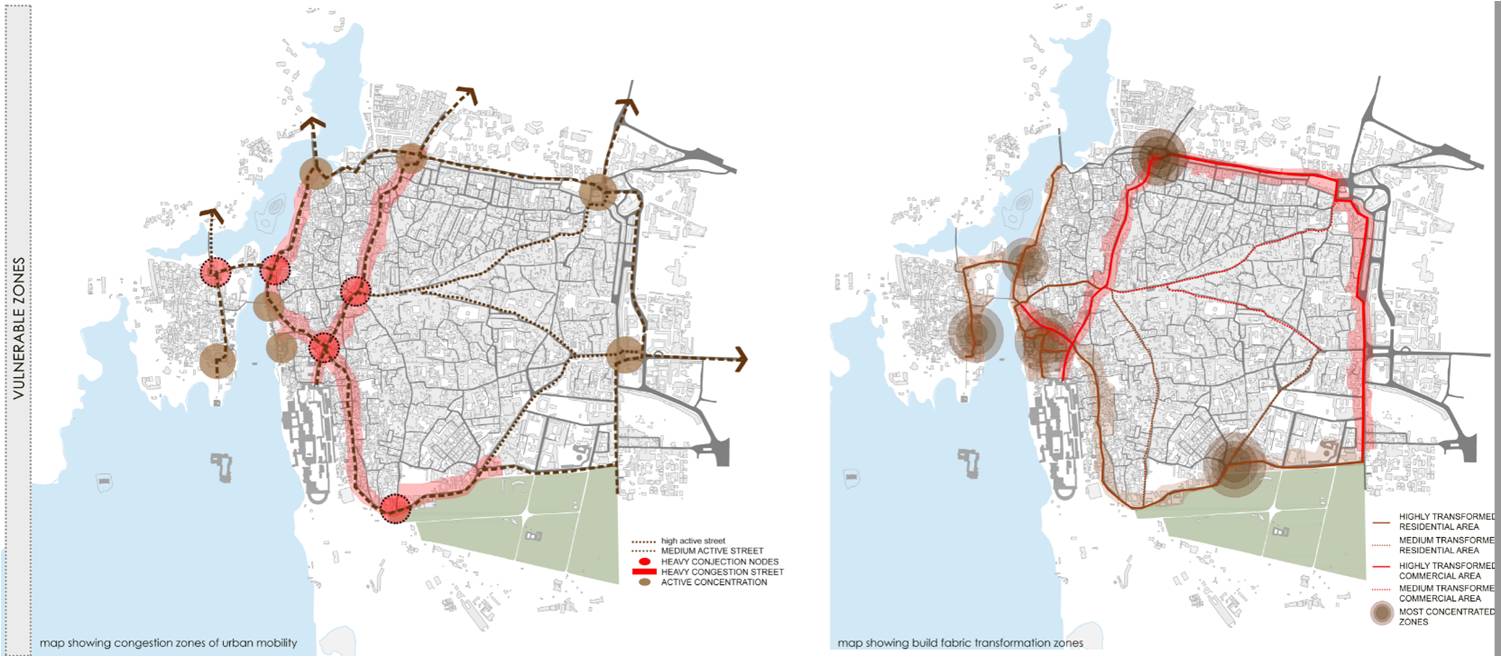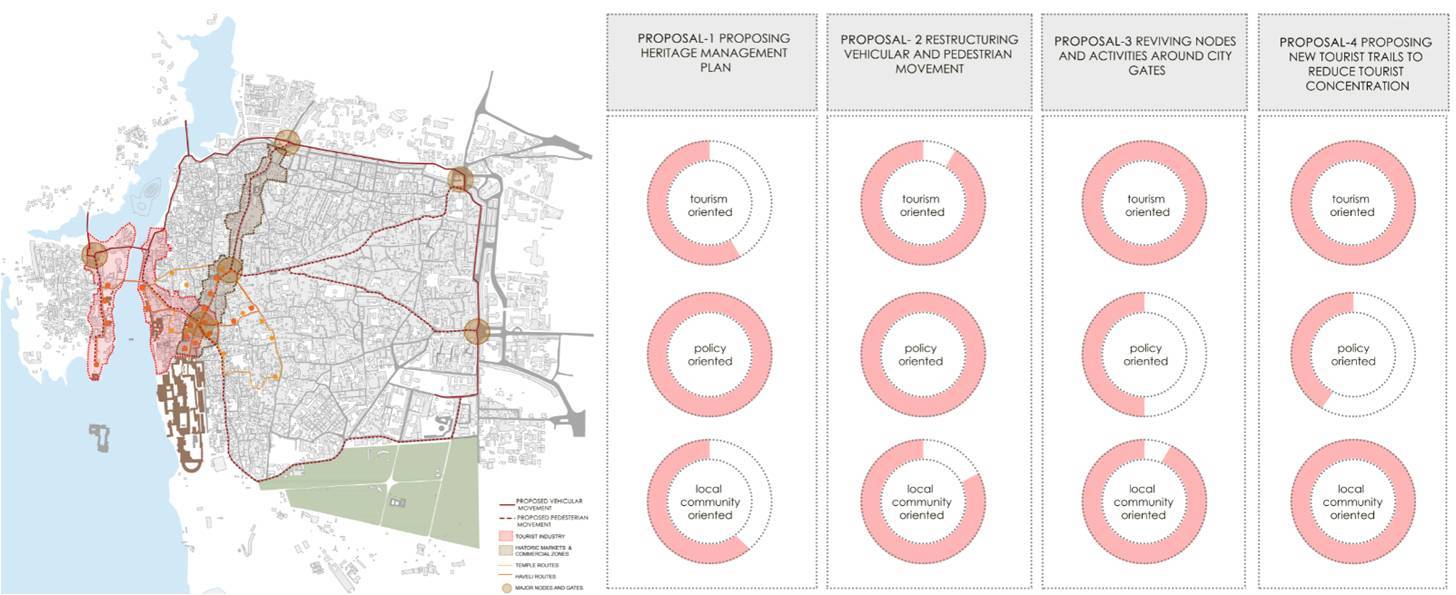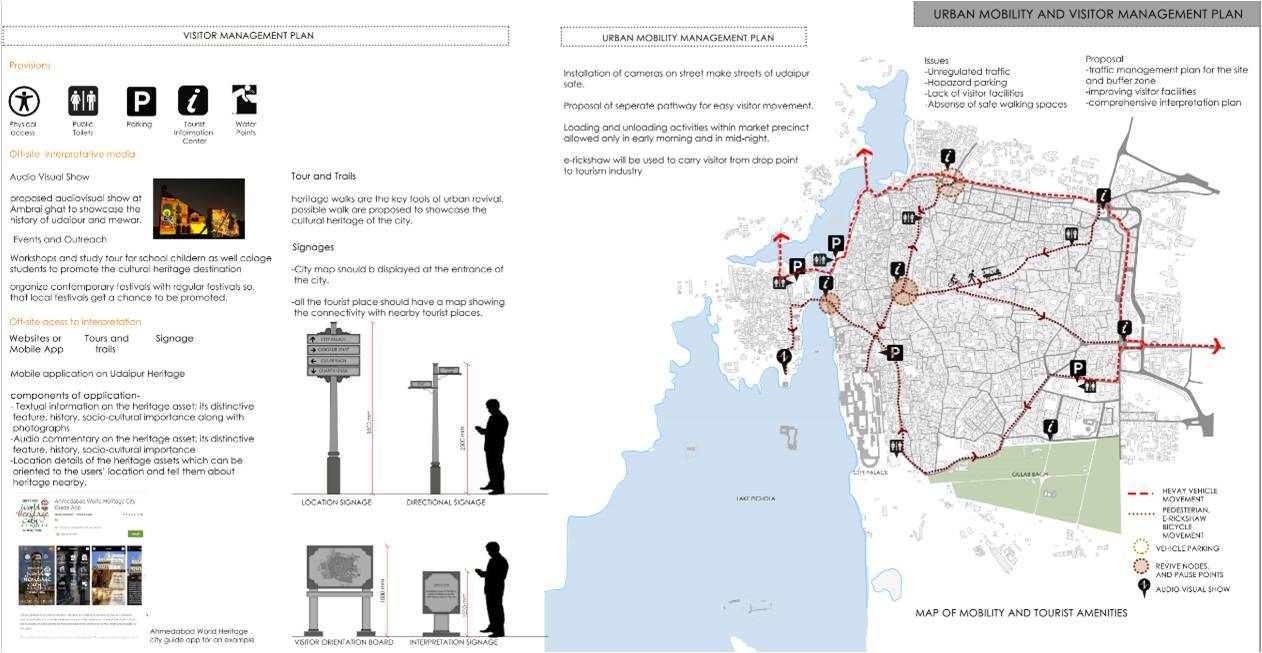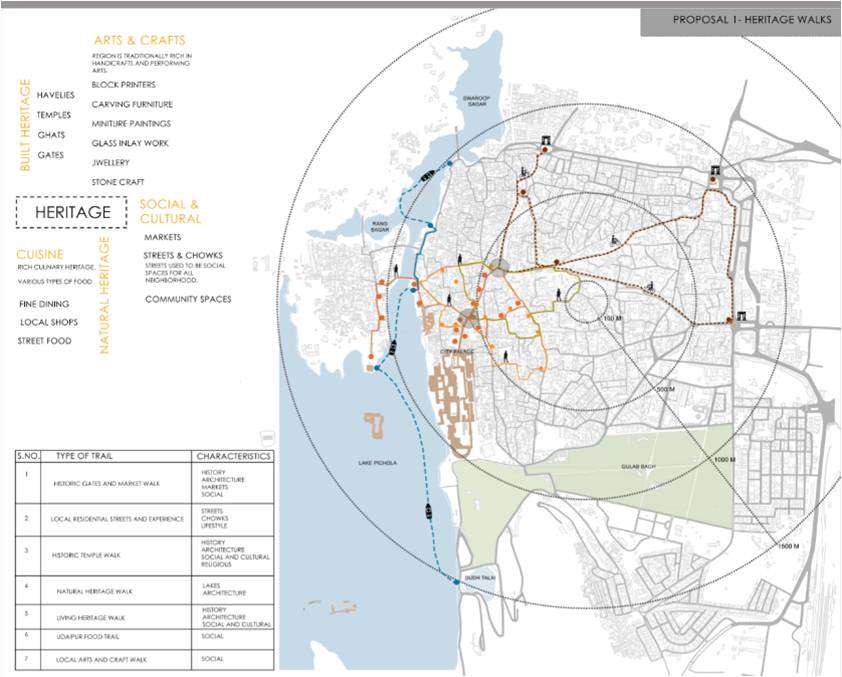UDAIPUR & the plight of Mass Tourism
Tourism is a global phenomenon and a growing industry that contributes to the country's economic growth. Increased leisure time and changes in lifestyle and consumption patterns have given renewed importance to tourism that either can encourage the preservation and maintenance of the cultural heritage or can be the reason of growing challenges in terms of traditional and socio-cultural systems of the host community and their activity, impacting the relationship of the environment with the built, the significance of the destination and the image of the city.
The state only cares about the increase in tourism influx. Marketing and branding are tools to achieve and attract a larger number of tourists. The tourism-related policies and schemes only talk about tourism promotion it does not talk about how to manage that large influx of tourist and their impacts. If this trend were to continue, the issues can intensify manifold inflicting serious threat to the current valuable surroundings, its urban areas and exquisite edifices.
Established in 15th century, Udaipur has a significant asset of heritage in its historic core. Heritage of the Udaipur contributes to the image of the city. Diversity of attractions and traditions plays a major role in establishing the Udaipur city’s identity as ‘city of lakes’ and heritage tourist destination. These heritage assets gave identity to the individual and sense of belongings. Udaipur is the largest district in the Mewar region and the centre of the social, economic, cultural, religious activities. The city’s heritage not only boosts of Palaces, Lakes, Ghats, Temples, Havelis, Historic gardens but also for the secondary attractions such as fairs, festivals, arts, crafts, dance, music and cuisine. The tangibles and intangibles of the historic core play an important role to create Udaipur’s image as a custodian of heritage and culture.
Many tourist destinations and their historic urban landscape have significant changes to provide a better image and experience to the visitors. The 5A's of tourism defined by Dickman in 1997 for a good experience of tourism represents
- Accommodation
- Accessibility
- Activity
- Amenities
- Attraction (Dickman, 1997)
Implementation of these aspects within the historic centre leads to change the original fabric and the historic, socio-cultural significance of the city. New demands and new culture change the everyday public space meaning to the locals. Urban spaces within a tourist destination became more privatized and everyday relation of the locals and destination became more formal. Policies and strategies framed for the betterment of experiences which sometimes disconnect the local with the spaces and commoditise the crafts and cultures. It indicates that the tourism industry has been converted into a commercial product and the social public spaces for used by community transform as a tourist space.
Tourists, heritage and communities are essential parts of the tourism life cycle. Tourism and community are the dynamic part of the cycle which can be changed and impact the heritage. Whereas heritage is a static element of the tourism life cycle, which largely depends on the behaviour of the community and the visitors. The community has the associational value with heritage. Tourists have attracted mainly a city's art, architecture, culture, history, and heritage
This increased tourism benefits economically but it also has impacts on the physical, socio-cultural and environmental fabric of the destination. The urban fabric of the location or tourist destination altered to serve the tourism facilities to provide a better experience to the visitors. It not only depends on the destination and its characteristics it also involves the marketing and the branding of the location in such a manner so that it can attract a larger number of groups.
This large number of groups 2 visiting the same location at the same time called as mass tourism. The management of this large number of tourists is necessary otherwise it can be the reason for the social, physical, cultural degradation of the city. Developing countries like India where tourism act as an important tool to generate economy and employment, in such case management of tourist and tourism industry is important to preserve and conserve the identity of the destination.
The architecture of Udaipur city introduces the visitors to the royal Rajputana history, culture and lifestyle of local communities. Fairs, festivals, tradition and customs followed by the local community also attract the visitors. A large number of tourists visit the place during the important festivals like Diwali and Christmas. The community plays an important role in development of tourism.
Both communities and tourism contribute to the conservation of history and heritage. Communities, their spaces, their activities and everyday urbanism not only give a character to the city but also a basic reason for tourists to travel and experience the city differently. Increased number of visitors, more than the carrying capacity of a destination, impacts not only the community and the lifestyle but also heritage and history. It creates imbalance between those three tourism, heritage, and community aspect. This mass tourism became the reason for the staged authenticity of the community and changes the activity pattern culture and traditions. The whole community has to be reproduced to conform to the image that the tourist has for it.
This increased tourism pressure leads to the commodification of traditional arts and crafts. Mass tourism changes the behaviour of the local communities. Local community's attitude changes toward tourists and tourism development in different stages of development's life cycle (Doxey, 1975). Increased number of visitors results in negative socio-cultural impacts which lead to irritation in the local community. To conserve and protect the heritage, urban fabric, history, traditions, and culture sustainable tourist development and balance between tourism, community, and heritage is necessary.
Tourism contributes to the growth of a particular destination and the host community as a small number of specific places visited. But as the number of visitors increases host community has lost its connection with heritage and growth. The economic impact leads to a positive direction but after a point of the time, culture and environment lead in negative directions. The support of the resident for tourism development is based on social exchange theory (Turner, 1986). The positive impacts of tourism can be described as employment generation, increased investment, development of basic infrastructure and revenue generations. And the socio-cultural impacts explained as commoditization and cheapening of culture and traditions, alienation and loss of cultural identity, undermining of local traditions and ways of life, displacement of traditional residents, loss of authenticity and historical accuracy in interpretation. (w.k. athula gnanapala, 2016).
This over-tourism changes the perception of the host community towards tourism. Modification of the historic urban landscape may lead to the loss of authenticity and aesthetic value of the destination. The impacts on the destination are not a sudden process, it happens in the stages and the understanding of the destination stage is important to manage in a certain direction.
The historic core reflects the Udaipur’s rich Rajputana heritage, architecture and culture. The morphology and planning of the walled city is organic in nature. Major streets form the major nodes which act as landmark. The historic core is a living heritage where markets and residential clusters coexist. The major spine has commercial shops with houses and inner lanes have residential quarters with temples and other cultural assets. The markets are based on the commodities and communities which also form the major intangible heritage in the city. The built form be it Palaces, Ghats, Havelis, Pols, Houses and Temples borrow heavily the elements of Jharokhas, Gokhras, Pols, Ada dwars and central courtyard. What adds to the sense of place is the presence of active tissue and activities on the streets and nodes. The tangible built form and intangible activities form a strong networked condition of heritage. Each street, every cluster has a mix of both – historic built form and traditional customs and practices. The architectural style, associational value of community with historic core, the economic and livelihood activities, the tourist circuits make it a thriving cultural heritage.
Tourist Destinations within the walled city is situated in a walkable distance. The historic core of Udaipur is approx. 1.5km x 1.5 km which is quite walkable. The Walled city can be accessed by private vehicles and auto-rickshaws. The streets of walled city are not meant of the heavy vehicles. This vehicular movement creates the situation of congestion which disturbs the activities of locals and visitors. Auto rickshaws and two-wheelers made the walled city pedestrian-friendly. The significant assets of historic core be it tangible heritage or intangible heritage of the Udaipur city contributes to the image of the city. The diversity of attractions and traditions plays a major role in establishing the Udaipur city’s identity as ‘city of lakes’ and heritage tourist destination. These heritage assets gave identity to the individual and sense of belongings.
The existing tourist trail goes through the main streets and leads to the main road. This starts from the Hathipole chowk and leads by following Hathipole Street and Ghanta Ghar Street towards the City Palace. These streets consist of the market for handicrafts according to visitor interest. Jagdish Chowk serves as a trail core portion linking both destinations and starting point. The trail leads to Gangaur Ghat and Ambrai Ghat to a panoramic view of Udaipur's historic core. The existing trail visits only a few destinations, resulting in a lack of engagement with less frequented walled town destinations. Tourist amenities largely include hotels and restaurants and parking, public toilets, information centre facilities.
The major concentration of the amenities is near the lake edge. The lake edge of Pichola has Hotels and guest-houses comprise the 5-star and 3star hotels. Most of the tourist amenities are located near the major tourist trails or streets. Cafes, restaurants, rooftop restaurants overlooking the lake are most popular among the visitors. The majority of the heritage hotels are converted to residential property. It is normal to add floors and alter the significant architectural character to turn the property into a hotel and café. Udaipur’s historic centre has only two parking spaces. These parking spaces are not enough to compensate for such tourist arrival. The provision of all aspects of amenities in a single zone has made it more congested, resulting in an influence on the site’s historical character and significance.
With the pressure of tourist development, the historic core of Udaipur is over burdened with issues related to crumbling heritage. The transformation of indigenous character to facilitate global forces has led to a situation where local cultural heritage is at loss. Alteration and additions of the floor in historic buildings, changes in daily activity pattern lead to disturbing the social and the physical characteristics of the city. The loss in the sense of street, architectural character’s transformation, increasing tourism industry activities change the uses of historic significant assets.

Change in land use and built form to facilitate tourism related activities has resulted in Gentrification and loss of community’s association with the heritage. Insensitive development, congestion of vehicles, loss in visual integrity due to alteration and additions of foreign elements lead to massive transformation in historic built form. The original communities have lost association with the core and have moved out to the newer settlements. This also impacts the intangible heritage of crafts and aboriginal livelihoods; making them just a commodity suited for tourist sale. Lack of heritage management and conservation guidelines have made it more vulnerable to the triggers of over tourism, Globalization and changing associational values of inhabitants. Increased vehicular movement in a walkable friendly core disturbs the life of locals. Heavy congestion, parking issues, lack of sidewalks, changes the perception and experience of the city. Many destinations face the high tourist influx due to the popularity but the rest of the destinations is which are not popular among the tourist degrades. Tourists take only a single route to enter the historic core, proposing more pedestrian-friendly routes, heritage walks to promote less-visited destinations and a comprehensive site management plan can control the impacts of the mass tourism industry.

The economy of Udaipur relies largely on the tourism industry. So, it is not possible to control tourists or stop tourists from visiting Udaipur city. As the local community relies on tourism it should be promoted on heritage costs and their significant properties. Mass tourism will further increase in Udaipur's Historic Core, so some management and action need to be taken before exploiting financial, economic, historical properties. Udaipur tourism needs to promote conservation management for long term sustainability.
The visitor experience can't be fixed in isolation. Tangible and intangible heritage, host community and the visitor can link to the historic center for restoration and rejuvenation. The study aims to control the impacts of tourism taking into account both the heritage and the community.
Thus, community engagement and participation in planning and management can further contribute to the preservation of identity where the historical center lies. Tourism of Udaipur is based on the cultural heritage, landscape, and Udaipur tourism is focused on the cultural heritage, landscape, and environment, and an independent approach to managing the impacts of tourism can only benefit to some degree. The larger picture will value the heritage and strike a balance between existing frameworks and modern developments. It's hard to avoid the city's development and growth but if this development happens correctly then the destination will become more convenient for the tourists as well as the locals and the identity of the city will remain the same.




About the Authors
Daksh Jain
Trained as an Architect (Honors in B. arch, Gold medallist; JNVU) and an Urban designer (kRVIA), Daksh Jain is a resident of Udaipur. His interests traverse in the domain of Urban planning, Urban design, Heritage conservation, Development finance and Policy framework. His works in academia follows the lines of Sociology, Ecology, Economics, Cultural studies, Informality and inclusive public oriented designs.
Currently, he is working as an independent researcher on the topic- City life, Culture and Consumption – Emerging urban phenomena.
He is also the recipient of Bhamashah Award for excellence in Academics by Eternal Mewar,Maharana Mewar Foundation in 2019.
Kavita Jadon
Jaipur based Architect & Urban conservationist, Kavita Jadon addresses the importance of historicity and heritage in day to day life. She has experience of working in the field to promote cultural heritage and its conservation. Her designs showcase use of classical architectural elements embossed in Indian style and materials.
Her interest lies in the conservation of intangible cultural heritage and historic built forms. An avid Rajasthani cook and dancer, she advocates on developing frameworks related to sustainable cultural tourism and community oriented tourist development. She has extensively worked in the documentation of heritage precincts in Ahmedabad, Jaipur, Jodhpur, Udaipur, Mumbai and Matheran.
To join us on Facebook Click Here and Subscribe to UdaipurTimes Broadcast channels on GoogleNews | Telegram | Signal


